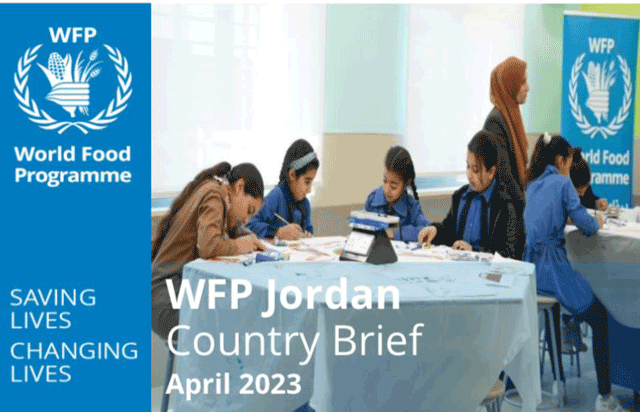You are here
As refugee food security returns to pre-pandemic levels, challenges remain — WFP report
By Mays Ibrahim Mustafa - Jun 03,2023 - Last updated at Jun 04,2023

AMMAN — Although the overall food security status of refugees has improved over the past year, certain household groups remain more vulnerable, and are therefore more likely to resort to negative coping strategies, according to the World Food Programme (WFP).
Examples of these vulnerable groups include households headed by women or unemployed individuals, as well as those including members with a disability, WFP stated in its Jordan Country Brief for April 2023.
The report cited the results of WFP’s Food Security Outcome Monitoring for the first quarter of 2023, which showed that refugees’ food security levels have returned to pre-pandemic levels.
However, the past year has also witnessed a 25 per cent increase in the average amount of debt among refugees in both host communities and camps, the report stated.
“Alarmingly, the dominant usage of debt is not for livelihood or business investment. Instead, food purchases, rent and health expenses consume most of it,” the report added.
The report also showed that the total funding requirements for WFP’s Country Strategic Plan for 2023-2027 equal $997 million and its 2023 funding requirements equal $230 million. So far, the WFP has received $116 million this year.
“Between May and October 2023, WFP requires $103 million to cover the food requirement of 465,000 refugees in camps and communities…,” it stated.
In April 2023, WFP assisted around 590,000 people and administered roughly $14.1 million in cash-based transfers, according to the report.
Around 459,000 refugees were provided with monthly food assistance through cash-based transfers in camps and host communities, 96 per cent of whom were Syrians, according to the report.
“In support of the National Financial Inclusion Strategy, WFP is promoting financial inclusion among refugees by transitioning from the use of WFP-owned accounts to mobile money, which is the only refugee-owned account model presently authorised by the Central Bank of Jordan,” the report added.
In April, 35 per cent, or around 111,000, of Syrian refugees in host communities received assistance through this modality, which was also introduced to over 1,600 families, equal to around 6,500 WFP beneficiaries, in the Azraq and Zaatari camps, the report continued.
Additionally, the report pointed out that Jordan, which hosts the second-highest share of refugees per capita globally, is a “resource-poor, food-deficit country with dwindling energy and water resources and limited agricultural land”.
It showed that roughly 660,600 Syrian refugees and 80,000 refugees from other countries were registered with the UN Refugee Agency (UNHCR), as of March 2023.
“This massive presence of refugees has put unprecedented pressure on Jordan's budgetary and natural resources, infrastructure, and labour market,” the report said.
“Nevertheless, Jordan has linked the attainment of its own national goals with a progressive approach to hosting refugees,” the report stated.
Related Articles
AMMAN — The World Food Programme (WFP) is reducing the value of its monthly assistance by one-third for 75 per cent of the 465,000 refugees
AMMAN — The World Food Programme (WFP) in September provided food assistance to some 462,000 refugees residing in camps and host communities
AMMAN — The United Nations World Food Programme (WFP) received a timely allocation of C$5 million (around $4 million) from the Government of















